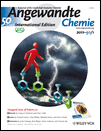50 Years of the International Edition: More Substance than Appearance
It must have seemed like a crash of thunder and bolt of lightning to many chemists in Germany in the early 1960s when the Verlag Chemie and the Gesellschaft Deutscher Chemiker (GDCh) brought out an “International Edition in English” to accompany Angewandte Chemie, the then almost 75 years old German chemistry journal. A half-century ago, only a handful of contributions in Angewandte Chemie came from authors outside of German-speaking countries, and it was certainly a courageous step for the Editor-in-Chief at the time, Wilhelm Foerst, and his successor Helmut Grünewald, to start an English edition. And indeed, in the first couple of years they needed the help of Academic Press in this endeavor. It hasn’t been passed down whether they had the undivided support of the Editorial Board, which in 1961 was made up of Richard Kuhn, Otto Bayer, Wilhelm Klemm, Klaus Schäfer, and Karl Winnacker. But today’s readers and authors, and of course also the editors, the publisher, and the GDCh, are most grateful to these pioneers for an internationalization of the chemical sciences. Shortly after the start of the International Edition, Wilhelm Foerst wrote a foreword to the 75th volume of Angewandte Chemie in 1963: “And so each fundamental piece of new knowledge emanates a sweeping power, which in turn motivates receptive personalities to their own achievements. It is this group, the avant-garde, that we are trying to find. That is our entire agenda.” This vision continues to guide the editorial team to this day, although the making of the journal has changed drastically since then, especially in the past 25 years—and it is these 25 years that I would now like to consider because I know them well from my own experience.
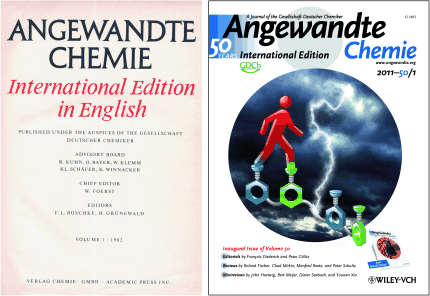

From the first volume in 1962 to the 24th volume in 1985, the International Edition grew from ca. 700 to ca. 1100 pages and from the 25th volume in 1986 to the 49th volume in 2010 from ca. 1150 to well over 10 000 pages (Figure 1). And speaking of growth: the 36 years of backfiles of the International Edition of Angewandte Chemie (1962–1997; starting in 1998, the journal was available online on Wiley InterScience) contains ca. 18 400 “articles” (including cover pictures, tables of contents, book reviews, etc.); in the 13 years since then, that is, since 1998, over 20 000 “articles” have been published. In 1986, the editorial office received only 426 Communications, of which 26 % came from outside of Germany (Figure 2); in 2010 there were circa 7300 submitted Communications, of which 89 % came from countries other than Germany. Submissions in 2010 were lead by China, the USA, Germany, and Japan, and the fifth place is taken by South Korea—before the other big European countries! The rejection rate increased from 30 % to 78 % over the past 25 years (Figure 3).

Page development of Angewandte Chemie from 1986 to 2010. In 1994 the frequency of publication was increased from 12 to 24 issues, in 2003 to 48, and in 2008 to 52 issues.

Number of submitted Communications per year since 1986 and their origin. Reviews, Minireviews, Essays, Highlights, Book Reviews, and other more rare article types are not included here.
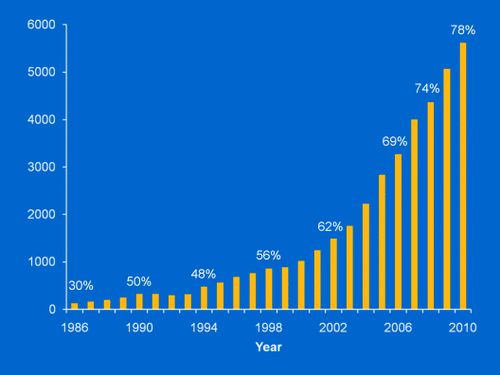
Number of rejected Communications (absolute and in percent) from 1986–2010.
Not just the numbers have changed dramatically. The entire publication process has changed, from the way the authors write their manuscripts to the way the manuscripts are handled in the editorial office and finally to the reception of scientific journals by readers. The fax machine was not around yet in the mid 80s, and today it has nearly disappeared again. There was no e-mail and no internet. Around 1986 the editorial office began to request floppy discs (5 1/4 inch) from authors to avoid having to re-enter text. The road from there to today’s seamless electronic treatment of manuscripts was not always easy, and it has required substantial investments by the publisher. Today the online version of a journal is the primary product, and some printed journals have shrunken their page format or been discontinued altogether. The more confidence is placed in the long-term archiving of electronic data (or the more the problem is blocked out), the faster printed journals will disappear. Reading behavior has changed such that for top journals like Angewandte Chemie, the homepage is checked for new articles on a daily basis. Figure 4 clarifies this point: A Communication that was published online in EarlyView on Wiley InterScience (now called Wiley Online Library) on a Friday had the highest number of “full-text downloads” that very same day. The weekend was quieter, and the few days immediately following again showed a high number of readers. After that, the interest waned, and it was briefly renewed when the issue containing the article was published online. The editorial office of Angewandte Chemie, with the support of many different departments at the publisher—whether it was called Verlag Chemie or VCH or is called now Wiley-VCH—has always reacted to suggestions from authors, referees, and readers to optimize the workflow for all involved and to make the printed and online versions of the journal as reader-friendly as possible: Constant innovation was and is key (Table 1). To achieve this, we have not lost track of the editorial “leg work”, the editing and the galley and page-proof corrections, although the effort invested here is constantly being adjusted to economical necessities and the expectations of authors and readers. And today this work, which takes place almost exclusively on-screen, is heavily supported by software.
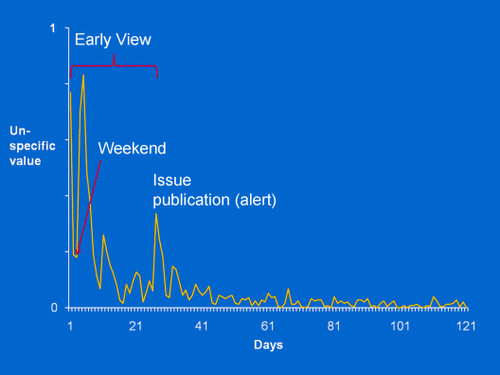
Online usage profile for a Communication published in Angewandte Chemie in 2010.
|
Year |
Innovation |
|---|---|
|
1888 |
First volume of Angewandte Chemie |
|
1962 |
First volume of the International Edition |
|
1978 |
Graphical abstracts |
|
1979 |
Cover picture for each issue |
|
1982 |
First personal computer in the editorial office |
|
1986 |
First floppy discs from authors |
|
1991 |
New section Highlights |
|
1992 |
First electronic editorial system |
|
1994 |
Increase of publication frequency from 12 to 24 issues |
|
1995 |
International Advisory Board established First internet service for readers |
|
1998 |
Regular press service Full-text articles online on Wiley InterScience |
|
2000 |
New section Essays Selected articles appear online first (EarlyView) |
|
2001 |
Color in the Table of Contents |
|
2002 |
Online manuscript submission |
|
2003 |
Increase of publication frequency from 24 to 48 issues New sections News, Obituaries, and Conference Reports Introduction of a fully electronic editorial work flow |
|
2004 |
Online publication of volumes 1–36 of the International Edition |
|
2005 |
All articles published in EarlyView first |
|
2006 |
Online publication of volumes 1–109 of Angewandte Chemie |
|
2007 |
New section Spotlights on Sister Journals Most accessed articles on homepage |
|
2008 |
Increase of publication frequency from 48 to 52 issues |
|
2009 |
New sections Author Profiles and Eyewitness Reports Angewandte Chemie on Twitter and Facebook |
|
2010 |
Certificate for referees Cover of the week etc. in EarlyView |
Regardless of innovation and leg work at the publisher, in the end—or rather, at the beginning of the process—a journal needs high-quality contributions, in order to be more substance than appearance; and these contributions come from authors and are critically analyzed by referees. The referees work anonymously, and I thank them in the name of the editorial office, the GDCh, the publisher, and the readers. This last group in particular profits from the careful selection of published articles, which are improved further by the referees’ critique and subsequent author revision. We began to recognize individual referees in 2010 by sending a certificate of recognition to those who wrote 12 or more reports for Angewandte Chemie in 2009. We received very positive responses and will continue the practice for 2010.
Of course Angewandte Chemie has many authors, and I once listed those who had published the most articles since the beginning of the International Edition (see the Editorial in issue 28/2004). Table 2 shows the names of the corresponding authors who have published 20 or more manuscripts in our journal since the year 2000. We are glad of every author who offers us his or her manuscript for publication—ideally after critical self-reflection as to whether the subject matter is suitable for the journal and the quality of the results is appropriate for its high standards. We especially thank the authors listed in Table 2 for their loyalty. In each issue since the beginning of 2009, we introduce an author who has published ten or another round number of articles in Angewandte Chemie since the turn of the century. After the Author Profile in this issue, written most wittily by K. Peter C. Vollhardt, is a table of the authors who have been highlighted to date. These Author Profiles are valued by readers and give authors a chance to “profile” themselves.
|
Name |
Publications |
Country |
Name |
Publications |
Country |
|
|---|---|---|---|---|---|---|
|
Nicolaou, K. C. |
108 |
USA |
Shibasaki, Masakatsu |
25 |
Japan |
|
|
Knochel, Paul |
54 |
Germany |
Shinkai, Seiji |
25 |
Japan |
|
|
Waldmann, Herbert |
51 |
Germany |
Buchwald, Stephen L. |
24 |
USA |
|
|
Müllen, Klaus |
48 |
Germany |
Carell, Thomas |
24 |
Germany |
|
|
Danishefsky, Samuel J. |
45 |
USA |
Grützmacher, Hansjörg |
24 |
Switzerland |
|
|
Beller, Matthias |
43 |
Germany |
Kim, Kimoon |
24 |
South Korea |
|
|
Osuka, Atsuhiro |
42 |
Japan |
Mulvey, Robert E. |
23 |
UK |
|
|
Braunschweig, Holger |
41 |
Germany |
Schultz, Peter G. |
23 |
USA |
|
|
Roesky, Herbert W. |
40 |
Germany |
Xia, Younan |
23 |
USA |
|
|
Fujita, Makoto |
39 |
Japan |
Antonietti, Markus |
22 |
Germany |
|
|
Carreira, Erick M. |
38 |
Switzerland |
Che, Chi-Ming |
22 |
Hong Kong |
|
|
Mirkin, Chad A. |
38 |
USA |
Giannis, Athanassios |
22 |
Germany |
|
|
Barluenga, José |
37 |
Spain |
Hoveyda, Amir H. |
22 |
USA |
|
|
Bertrand, Guy |
36 |
USA |
Leigh, David A. |
22 |
UK |
|
|
Fürstner, Alois |
35 |
Germany |
List, Benjamin |
22 |
Germany |
|
|
Willner, Itamar |
35 |
Isreal |
Maruoka, Keiji |
22 |
Japan |
|
|
Jørgensen, Karl Anker |
34 |
Denmark |
Meijer, E. W. |
22 |
Netherlands |
|
|
Stoddart, J. Fraser |
33 |
USA |
Schlögl, Robert |
22 |
Germany |
|
|
Diederich, François |
32 |
Switzerland |
Thomas, John Meurig |
22 |
UK |
|
|
Férey, Gérard |
32 |
France |
Yamamoto, Hisashi |
22 |
USA |
|
|
Kitagawa, Susumu |
30 |
Japan |
Driess, Matthias |
21 |
Germany |
|
|
Baran, Phil S. |
29 |
USA |
Frenking, Gernot |
21 |
Germany |
|
|
Niemeyer, Christof M. |
29 |
Germany |
Jacobsen, Eric N. |
21 |
USA |
|
|
Wong, Chi-Huey |
29 |
Taiwan |
Lehn, Jean-Marie |
21 |
France |
|
|
Fu, Gregory C. |
28 |
USA |
Müller, Achim |
21 |
Germany |
|
|
Kobayashi, Shū |
28 |
Japan |
Malacria, Max |
21 |
France |
|
|
Jansen, Martin |
27 |
Germany |
Mayr, Herbert |
21 |
Germany |
|
|
Kunz, Horst |
27 |
Germany |
Power, Philip P. |
21 |
USA |
|
|
Ley, Steven V. |
27 |
UK |
Schüth, Ferdi |
21 |
Germany |
|
|
Reetz, Manfred T. |
27 |
Germany |
Scheer, Manfred |
21 |
Germany |
|
|
Schnöckel, Hansgeorg |
27 |
Germany |
Würthner, Frank |
21 |
Germany |
|
|
Trost, Barry M. |
27 |
USA |
Grubbs, Robert H. |
20 |
USA |
|
|
Corma, Avelino |
26 |
Spain |
Hayashi, Yujiro |
20 |
Japan |
|
|
Whitesides, George M. |
26 |
USA |
Kennedy, Alan R. |
20 |
UK |
|
|
Aida, Takuzo |
25 |
Japan |
Ma, Shengming |
20 |
China |
|
|
Cronin, Leroy |
25 |
UK |
Oshima, Koichiro |
20 |
Japan |
|
|
Feringa, Ben L. |
25 |
Netherlands |
Reinhoudt, David N. |
20 |
Netherlands |
|
|
Möhwald, Helmuth |
25 |
Germany |
Shinokubo, Hiroshi |
20 |
Japan |
|
|
Que, Lawrence |
25 |
USA |
The cover pages and Communications frontispiece (online as “Cover Picture of the Week” etc.) are also good places for authors to profile themselves. Starting in this issue, this chance will also be available using the back cover page. The cover pictures in Angewandte Chemie have been around since 1979, and many of them have high didactic value and give a clear presentation of current topics. The whole collection can be viewed in the cover picture gallery on the journal’s homepage. The cover picture of this issue, created by David Leigh and co-workers, inspired me to the introductory thunder-and-lightning metaphor. And that is exactly what every cover picture, every manuscript, and every issue of Angewandte Chemie should do: inspire new ideas and ignite sudden inspiration! The current “anniversary issue” is especially suited to this role. It has more Reviews, Minireviews, and Essays than usual, and they cover the full breadth of chemistry, from bio to nano! The authors of this issue come primarily from the Editorial Board and the International Advisory Board, and more articles from these groups will appear throughout the 50th volume of the International Edition. Apart from the “more of the best” agenda, the Angewandte Chemie homepage will have various features reflecting the past 49 volumes of the journal. For example, every day will highlight a different “Article of the Day”, which refers readers to a past article that has been particularly highly read or highly cited.
What does Angewandte Chemie have to do with the GDCh? The journal simply belongs to the German Chemical Society, and so, for example, GDCh committees decide who is appointed to the Editorial Board and the International Advisory Board. Prof. Manfred Reetz’s term on the Editorial Board ended in 2010; new appointments are Prof. Alois Fürstner and Prof. Christof Niemeyer; new members of the International Advisory Board are the professors Wilfred van Gunsteren, Itamar Willner, and Younan Xia (you can find more about all of these scientists in the News section of this issue). Prof. Reetz has written a “farewell” Review for this anniversary issue. The editorial office and the publisher as well as the GDCh thank him for his dedicated contributions to the Editorial Board (2002–2010).
The GDCh is taking the publication of the 50th volume of the International Edition and the International Year of Chemistry as an opportunity to hold a one-day symposium together with the Chinese Chemical Society (CCS) in Beijing on June 22nd and with the Chemical Society of Japan (CSJ) in Tokyo on June 20th. Nobel laureates Hartmut Michel (a member of the Angewandte Chemie editorial board since 2004), Ryoji Noyori, and Barry Sharpless will be among the speakers. This is especially pleasing, as 2011 is the tenth anniversary of the Nobel Prize for the latter two, and the legendary “click” article by Sharpless et al. was published in Angewandte Chemie exactly ten years ago. For the GDCh, Editorial Board members François Diederich (chairman, see also his Editorial in this issue) and Alois Fürstner will give talks in Beijing and Tokyo. Chinese and additional Japanese speakers will be announced shortly. It is fitting that in 2011, the International Year of Chemistry, Angewandte Chemie celebrates the publication of the 50th volume of the International Edition!
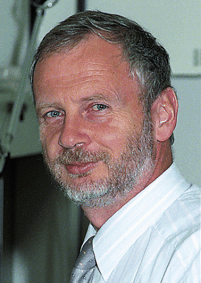
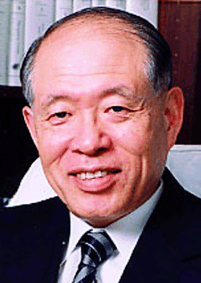
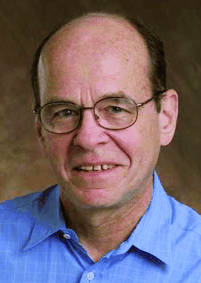
Peter Gölitz
PS: From 50 to 5, Chemistry—An Asian Journal, which was founded with the support of Angewandte Chemie, published its fifth volume in 2010. The journal’s enormous success exceeds the high expectations.



